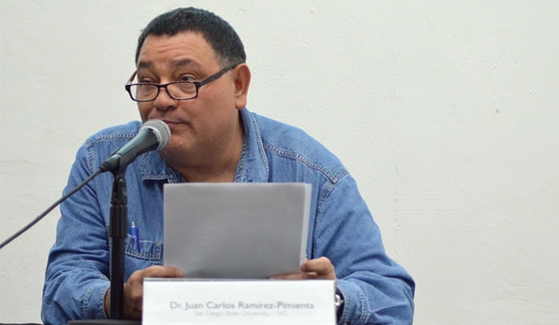How Corridos Transcend Borders: Q&A with Juan Carlos Ramirez-Pimienta
SDSU Imperial Valley Spanish professor dives into the cultural impact of Mexican regional music and the rising popularity of corridos.

Inspired by his own culture and upbringing, Juan Carlos Ramirez-Pimienta, Spanish professor at SDSU Imperial Valley, has been recognized as a leading expert in the culture of narcocorridos, U.S.- Mexico border literacy and the impact of Mexican regional music.
Ramirez-Pimienta has authored the books, “De El Periquillo al pericazo: ensayos sobre literatura y cultura mexicana” (2006); “Cantar a los narcos: voces y versos del narcocorrido” (2011) and “Una historia temprana del crimen organizado en los corridos de Ciudad Juárez” (2021).
SDSU News Team’s Daniella Rodiles connected with Ramirez-Pimienta to discuss the rising popularity and impact of corridos tumbados in the past few years.
What are corridos and how did they become so popular?
Corridos are Mexican narrative ballads. Why they are so popular in Mexico and within the Mexican American community is a multifactorial mystery.
Ballads in general were prevalent in many places in Europe, such as England, Ireland, Scotland, France, Italy, Spain and many other regions. In all those places, they only remain as archaeological, folkloric music. The ancestry of Mexico's corridos was brought to the New World by the Spanish and Portuguese conquistadores. In Mexico and the Mexican population in the United States, ballads not only survived, they are the most successful segment in the musical industry. The anti-establishment narratives that many corridos present obviously still resonate within the Mexican communities, both in Mexico and in the U.S. They clearly still need corridos to tell their stories.
Subgenres of corridos have generated a lot of debate, most recently corridos tumbados. But not all corridos are controversial. Are there any misconceptions about corridos you’d like to dispel?
The most important misconception would be the preconceived ideology of corridos. As a genre, corridos have no ideology. Individually, they have the ideology of the corridistas, or the composers. Corridos are thought of as being the songs of the people, the voice of the people and they often are, but the people are not monolithic. Corridos can either be progressive, but also very conservative. The corrido corpus is full of misogynistic and racist lyrics. Corridos should not be idealized nor vilified.
Corridos tumbados has been rising in popularity among Mexican and Latino young adults, which puts the Mexican music industry in the global spotlight. What has been the impact of that so far?
I still think it is too early to tell. The speed with which the music business moves today is difficult to even conceive.
Not even a year ago, only those who closely followed the development of Mexican regional music (and in particular the corridos) knew the name of Peso Pluma. How could someone like that, with such a short musical career, be competing for the top global spots with established musical stars like Taylor Swift, The Weeknd and Bad Bunny?
At the end of May 2023, Hassan Emilio Kabande Laija, known professionally as Peso Pluma, had seven songs placed among the 30 most listened to globally, in different duets. No other artist had so many songs placed so well on this list.
I believe we are at a threshold of a resignification of Latino and, more specifically, Mexican identities. By this, I mean a recalibration of how Mexican identities and Mexicanness are perceived in the world. Also, I believe that since at least a decade ago we have been experiencing an erosion of the English language as the musical (world’s) lingua Franca. English still is omnipresent but sharing the spotlight with Latino rhythms such as reggaeton and now with Mexican music, especially corridos tumbados.
What can students expect from your new class about corridos and Mexican music?
They can expect to listen to a lot of corridos. They can expect to be asked to open up to new learning paradigms and go from a cosmovision to an audiovision of the world. The class is structured diachronically, as a survey, from the earliest corridos to the newest promotions. They can expect to come out of this class with a much deeper understanding of one of the most important Mexican cultural productions; one that is certainly a topic of debate.
What is your favorite corrido?
It is difficult to choose just one. I really like “El Corrido de los Perez,” a corrido from the early 20th century about a family feud in Jalisco – the Perez family against the DeLuna family. This old school corrido manages to tell this tragedy in just three and a half minutes. The song is full of poetic imagery. It proves that the aesthetic divide between highbrow poetry and popular poetics often is artificial.
I have another two sentimental favorite corridos: “El Pablote” y “La Piedrera” (“Big Pablo” and “Rock Querry”) because they were the impetus for two of my books: “Singing to Drug Traffickers” and “An Early History of Organized Crime in the Corridos of Ciudad Juárez.”
Is there anything else about corridos you’d like to share with our readers?
On an optimistic note: just to say that while it is true that a lot of corridos tumbados present a narrative of social and economic mobility through crime and violence, I am not as preoccupied as other social commentators. I give more credit to the listeners, especially to the new generations.
I believe they have agency and they use it when listening to these songs. They do not simply ingest uncritically the messages in the corridos’ lyrics. Often, they recalibrate them. They get the empowerment message but re-semanticize it.
For instance, one of the most popular corridos of the summer had as its title and main verse “Dijeron que no lo iba a lograr” (everybody said I would not make it). The corrido is a story of triumph and achievement through crime, but many listeners transformed this message and used it to illustrate their graduation videos in TikTok. Graduation videos, from various universities, emphasizing how nobody believed they were going to make it and how they overcame adversity.
That is what I want to share to our readers, to trust the new generations, they are not just passive listeners or consumers of popular culture.


